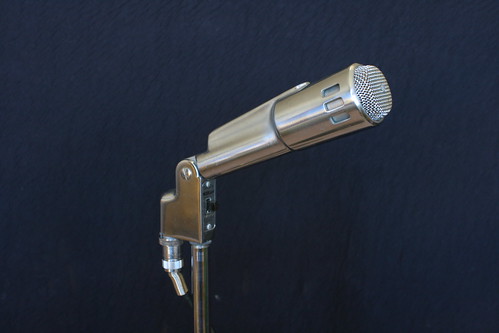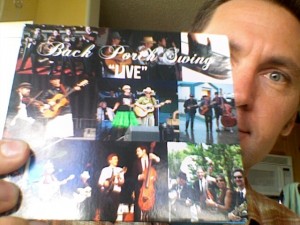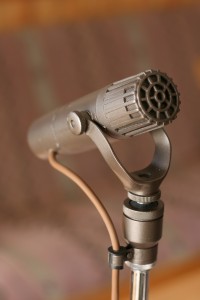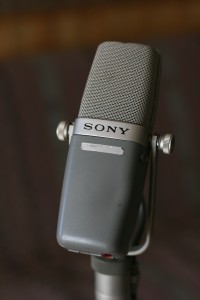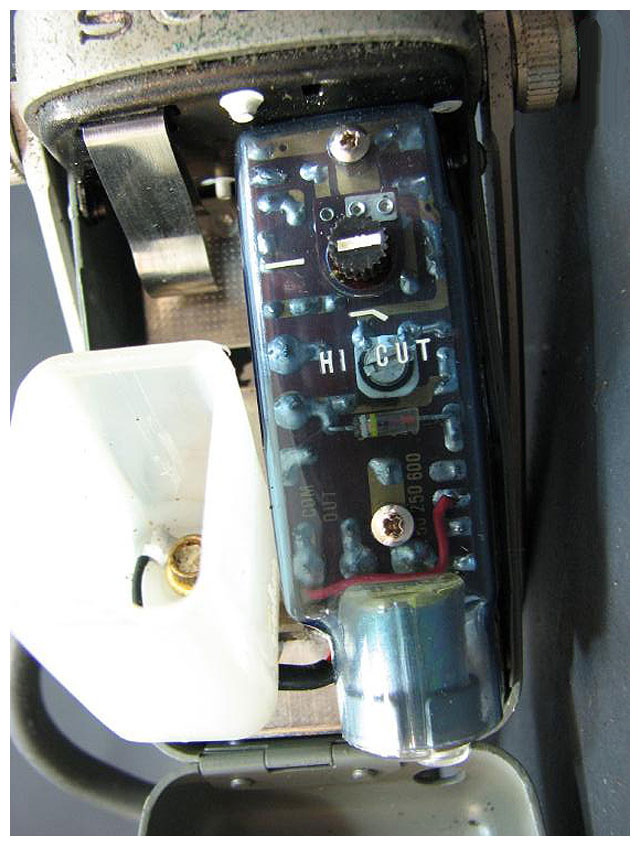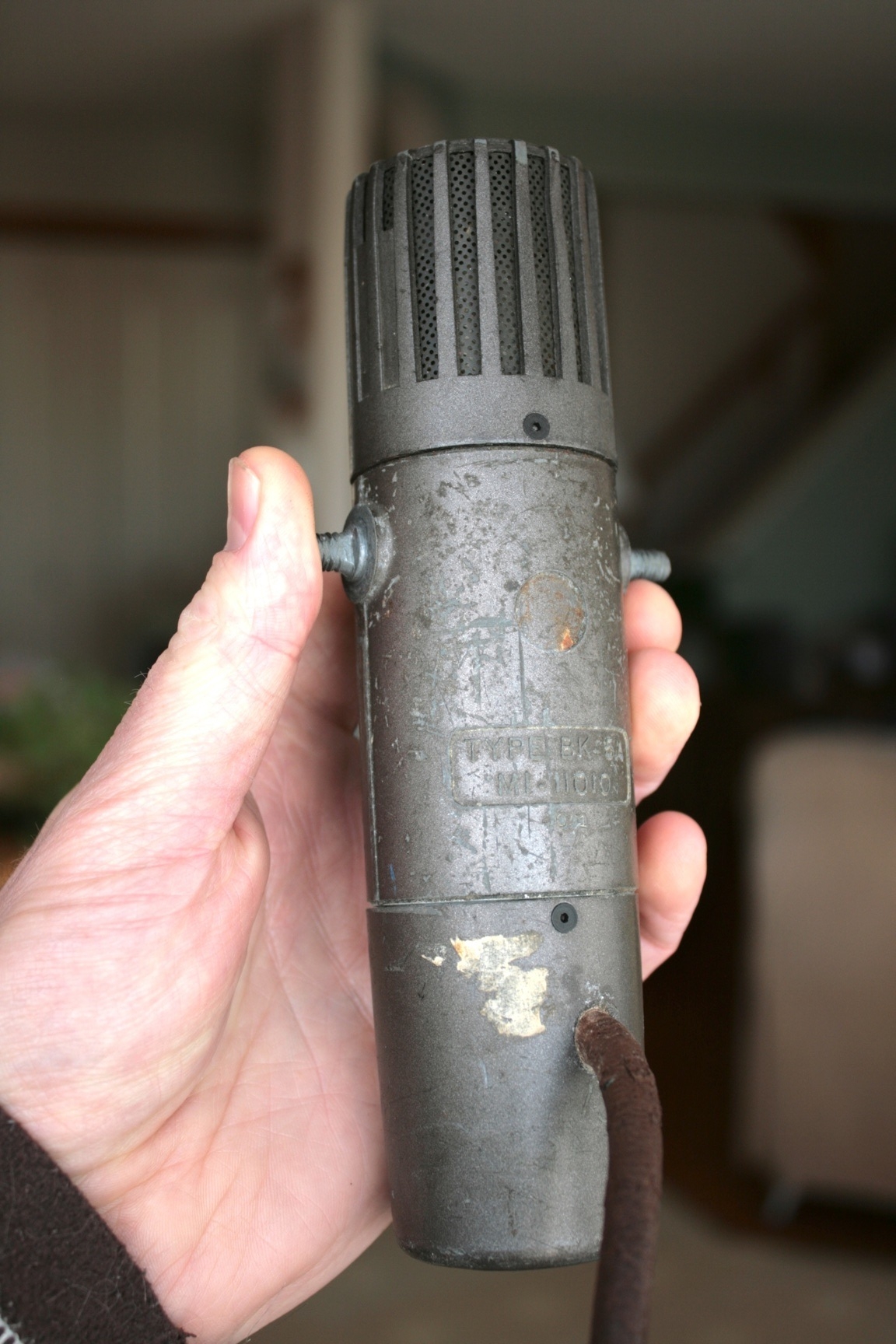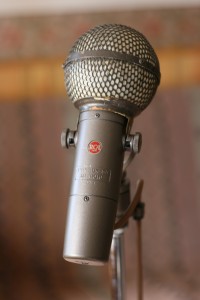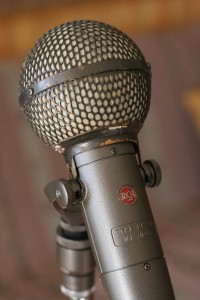Another Electro-Voice 664
In a previous entry, I talked about a cool old mic, an Electro-Voice 664 dynamic mic from late 1950 to early 1960s, I had in for repair. I found one for sale for cheap. It's a little different from the one I had in for repair.
This one has different side vents, and a different label and logo. The four pin cable connector at the mic end is a bit different too. It's easy to change from high to low impedance just by pulling the pin out from position 2 to 3. On the first mic, I had to resolder the wire into another pin. Here are a few pics of this mic.

My EV664 dynamic mic.
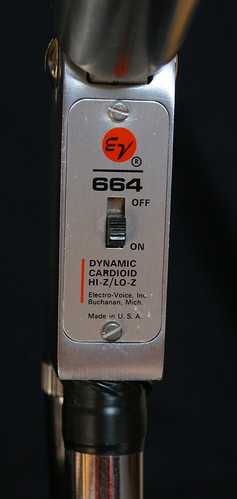
EV664 - label plate.
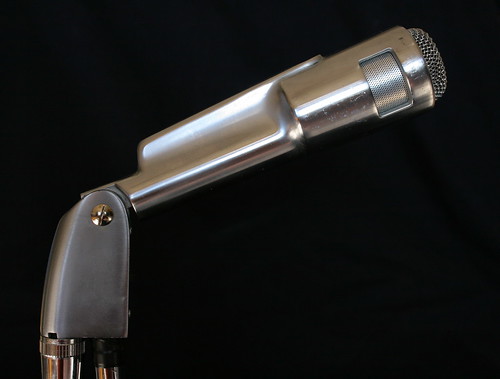
My EV664 - side view.
It sounds pretty decent, but it needs a bit of eq. Right now I have it set up as my talk-back mic, but I'll probably try it out on a few instruments. I've heard people use it on kick drum, guitar amps, and upright bass. Apparently ZZTop has used these mics on their stage show, but they had the capsules replaced. See this for example. I guess it's mostly for show. I've seen pics of Arcade Fire using them too. There are a bunch of pics here. For comparison, see the other one over here.
Electro-Voice 664 Dynamic Microphone
I got this cool old microphone in for some minor repair. It's a classy-looking art-deco kind of mic from the 1950s and 60s, with a very durable chrome finish.
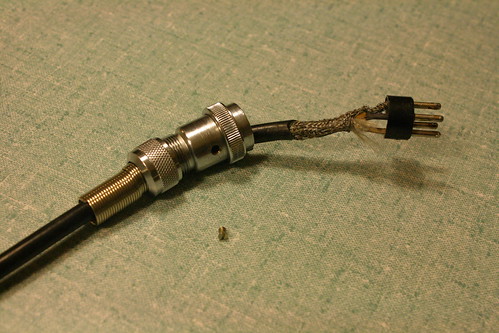
Electro-Voice Model 664 - four pin connector at the mic end.
This one is in really good condition, complete with a solid cable (I don't think it's the original). I soldered a modern XLR connector on the end. It appears they usually came with a 1/4" phone plug. It can be set for high impedance or low impedance (150 ohms) by swapping the white wire in the four-pin Amphenol connector at the mic end. It was originally set for high impedance, which is likely most suitable for plugging into a guitar amp. I tried the mic out that way, plugged into my Allen & Heath console, and it didn't sound very good. It was a little tinny (using my voice as a source), and there was significant noise being picked up. High impedance sources are much more susceptible to picking up electromagnetic interference.
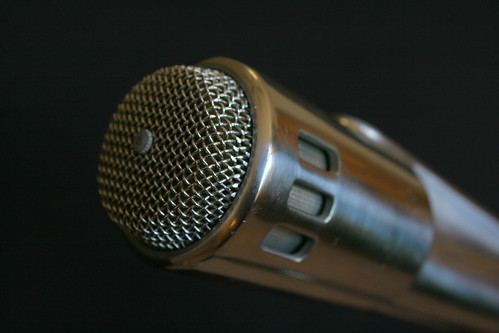
Electro-Voice Model 664 Dynamic Mic
So I swapped the white wire from pin 2 to pin 3 at the mic end. The instructions talk about pulling the "slip pin" out to effect this change, but this connector had the wire soldered into the pin. After the swap, it sounded way better, and the noise was gone. I pulled out a little 1 kHz and boosted about 120 Hz a little, and it sounded pretty good on voice. Looking at the frequency response, this mic really rolls off the low frequencies in order to reduce the proximity effect. The response curve from the data sheet shows 100 Hz to be 5 dB down compared to 1 kHz, so I guess I'm levelling that off a little.

There is more information on Recording Hacks, and some great pics and the engineering data sheet on Coutant's website. Read some background on the Variable-D design on ProSoundWeb and EV's website.
I've got a bunch of pics on my flickr. This is such a groovy looking mic, it's too bad I have to give it back to the owner!!
Back Porch Swing “Live”
The new cd from Back Porch Swing is now available: Back Porch Swing "Live". It contains a selection of live performances we've selected from the past several years of performing. I brought a small stereo recorder to our shows, and recorded the live mix from the mixing board. The sound quality is not perfect, and there's a wee bit of extra noise, but the "liveness" of it makes up for it. There are a few original tunes, and several favourite cover tunes. We have a special guest guitarist on a few of the tracks too!!
For now it's only available at our gigs, but watch for more news on how to order it.
Memeza Africa – 3rd Canadian Tour
A fantastic choir from South Africa is back once again for a coast-to-coast Canadian tour. I have had the pleasure of recording them, and traveling with them on tour as their bass player. Beautiful people and great singers and dancers!
They start off in Trail, BC on January 25, 2011, and hit numerous provinces, ending up in New Brunswick on February 25, 2011. Last time they were here was early 2009, and they were a big hit, with numerous sell-out shows and raving reviews. Their full schedule is on their website.
There are lots of pictures from the 2009 tour here.
Some pictures from the 2011 tour are here.
A Wired Article on Ribbon Mikes
This article just appeared in Wired. Here is a great quote: "We'll have bands come in and pick up that BK5 like it's coming out of the tomb of Tutankhamen," says Vanderslice, "Like it has this divine healing property. ..."
I have an RCA BK-5A ribbon mike in my studio and have used it on a number of things. Yeah, it sounds pretty good.
I guess I can now offer Divine Healing services! I better increase my rates!
Actually, Vanderslice continues: "... In the scheme of things, the content of the music, or the lyrics, or the sound of electric guitar or the amplifier, it is a very small percentage of what's going on."
Music?? Lyrics?? That stuff matters? Doh!! 😉
Ribbon Mike Restoration
Here's an interesting article about the guy who restored my RCA BK-5A:
More on the Bluegrass Mike Technique
Recently, I had the opportunity to use an Audio-Technica AT4050 large diaphragm, multi-pattern condenser microphone as a single-mike at a bluegrass concert. I switched it to cardioid and it sounded really great - probably my favourite so far. Everything was so clean and clear. The vocals (a group of women), and all of the instruments (guitar, mandolin, fiddle, autoharp, penny whistle) sounded perfectly natural. I had the upright bass plugged in which helped fill out the bottom end. It was noticeably missing when I tried turning off the bass channel. I used two matched Oktava MK-012 small diaphragm condensers for side mikes, and they worked great. I used them with hypercardioid capsules. The mandolin and one acoustic guitar used them for instrumental breaks.
In the past I have used:
AT3035 - it's a fairly cheap mike, but sounds pretty decent for the money.
Rode K2 tube mike - sounded really good with a variety of voices and instruments.
AKG 414 - also very good.
Rode NT1000 - pretty decent.
They all work pretty well, but they each have a slightly different characteristic.
Sony Condenser Mikes From The 1960s.
I have this old Sony condenser mike.
From the pictures and information I found on the web here, I thought it was a C-37-FET. I don't have the power supply that came with it, so I found circuit schematics to figure out how to hook up the five pin XLR connection. I tried reverse engineering the circuit in the mike, and found it's not quite like the circuit diagram in the C-37-FET Technical Manual (which is available on the above web site). Eventually I realized that it is in fact a C-38A (or B??), a 1969 update of the C-37 mikes! There isn't much info available on this mike - it seems quite rare - and I'm not sure all of the information I've found on the web is completely accurate. Apparently this mike has been used at Abbey Road studio to record the Beatles, and Herb Alpert's trumpet on A Taste of Honey:article here.
Update 2010.11.05: new information I have received indicates that my mike is almost, nearly, just about, absolutely for sure a C-38B.
I did get the mike working by building a simple five-pin to three pin XLR converter. The mike can be operated with a 9V battery inserted or an external 9V power supply. Both of these methods can be remotely switched. I suspect it also can run from phantom power since there is a centre tap off the transformer that feeds the powering circuit. But I need to verify that there is a voltage regulator that drops 48 VDC to 9VDC so the DC-DC converter doesn't get fried. The information I found on the web suggests the C-38B, made in 1971, was modified to be used with phantom power. I'm almost sure that this one is not a C-38B, because it seems the C-38B has a three-pin XLR connection, while mine has a five-pin. The guy I got this from has the exact same mike with the power supply and the storage box with the model number on it (C-38A). Turns out his is a C-38B - but the box is from a C-38A!
There a few differences between the C-37-FET and the C-38B. The switch on the C-37-FET can be set to BAT to check the condition of the battery. On the C-38B, the switch is mechanically blocked from going to that position. So don't bother trying (I did). The internal circuitry is somewhat different, but I haven't completely traced out the schematic yet. There are differences in the two internal switches (high cut and 8 dB pad) - see the pictures below. The C-37-FET pictured doesn't have a pad switch.
Below is the powering diagram from the C-37-FET Technical Manual, which also works with the C-38A/B. Option 1 uses the internal 9V battery, and the switch allows you to turn it off remotely. The switch on the mike has to be on. Option 2 uses the internal 9V battery and has the mike on any time the connector is connected and the switch on the mike is on. This is how I wired my connector gizmo. It seems option 3 is slightly wrong. The jumper between pins 1 and 5 is also necessary here (or connect pin 5 to the shield - same difference).

C-37-FET powering
Here is a summary of the information I have found on similar Sony mikes (I got this info from the internet and some sleuthing, so I'm not 100% sure of its accuracy. If you have any corrections please let me know.):
C-37A: A tube condenser mike introduced by Sony in 1958 intended to compete with the Neumann microphones. Because of the tube circuitry it requires a special external power supply.
C-37P: A FET version of the mike that can be powered with 48VDC to 54VDC phantom power.
C-37-FET: Made in about 1965, it's a version of the C-37A that uses a field effect transistor (FET). It can be powered with an internal 9V battery or an external 9VDC power supply. It has a five pin XLR connector for powering and remote switching.
C-38: I'm not too sure about this one, if it existed. It could be simply a re-labelling of the C-37-FET, or people just dropped the 'A' when referring to it. One source says that the C-38 and the C-37-FET are the same: the C-38 was sold in Japan and the C-37-FET was sold in the US. Update (2010.10.29): I found pictures and some brief information on the C38. It was built in 1965 and the windscreen design is quite different from the C-38A and B. It looks like the C-37-FET inside and out from the photos, but I have no documentation on the C38 to verify if the two are identical.
C-38A: An update of the C-37-FET, introduced in 1969 with a new windscreen design. It has a five pin XLR connector for powering and remote switching. Can be powered by an internal 9V battery or an external 9VDC power supply, and possibly phantom power (I will try to verify this). Update 2010.11.05: A service manual I have obtained (copyright 1980) for the US indicates that the C-37-FET and the C38A have the same internal circuitry. No phantom powering!
C-38B (1971): An update of the C-38A, introduced in 1971. I think it had a three five pin XLR connector (not sure - I have no documentation). Can be powered by an internal 9V battery or 24VDC to 54VDC phantom power.
C-38B (1977): A further update of the C-38B. According to a service manual I have found, it has a three pin XLR connector. It can be powered by an internal 9V battery or 24VDC to 54VDC phantom power.
C-38B (2003): Sony re-released the C-38B in 2003. Can be powered by an internal 9V battery or 24VDC to 48VDC phantom power.
If you have any information about any of these mikes, or corrections to the above, please send it to me, especially the C-38A and C-38B (original) since that information is quite rare. This blog entry has become a little messy with corrections, so I plan to write an updated entry with the most complete information I can find. Owner's manuals and schematics would be great. Thanks!
Edit: Apparently this mike is the classic Manzai mike in Japan (thanks ratite!!). See this.
Restored RCA BK-5A
The RCA BK-5A ribbon mike is back in my hands. Here is a before picture, followed by some after pics. The mike was sanded and repainted to the original colour. The ribbon was completely missing inside the mike (which is what I suspected - I couldn't find one when I took it apart), so Clarence cut a new one and installed it according to the original RCA specification (size, tension, etc.). He put on a new cable since the old one was cracking up. The little screws were mostly missing, and the ones that were there were stripped, so they were all replaced. I didn't have the original shock mount, so Clarence supplied a reproduction shock mount that looks like the original. This mount was pretty expensive, but what are you gonna do. He supplied the knurled knobs for the mount, but unfortunately the threads on the mike are kind of screwed up - somebody must have cranked on the wrong size thread. So I'm not sure how to fix that. I had the little RCA medallion and so that is glued back on. It looks pretty good, and now it's time to check how it sounds.
Read more on ribbon mikes here.
RCA BK-5A
A quick update ... my RCA BK-5A ribbon mike has been restored by Enak Microphone Repair, and is on its way back to me! It should arrive within a few days along with a repaired mount for my old Sony C37-FET condenser mike. I can't wait to try it out on a vuvuzela. Actually, the only reason I said vuvuzela is to see if I get more google hits. Vuvuzela ya later.
